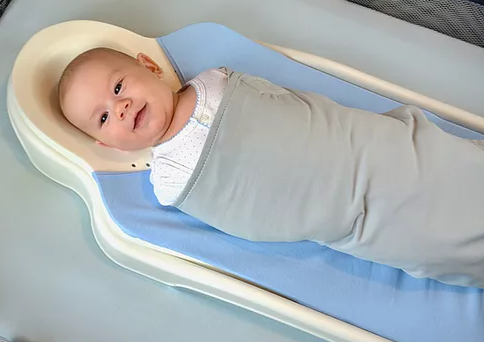Understanding Plagiocephaly for Parents
Plagiocephaly is a relatively common condition characterized by a flat spot on the back or side of a baby’s head. Don’t worry, it is no one’s fault and can be easily and quickly treated.
Plagiocephaly, also called “flat head syndrome,” can be caused when the baby’s head frequently rests in the same position on everyday surfaces such as a mattress or car seat, or it can even happen in the womb. It can develop in as little as one week and is present to some degree in nearly half of infants.
If left untreated it can result in the head being permanently misshapen, which can cause other issues including facial asymmetry, difficulty fitting helmets and eyeglasses, and jaw misalignment.
Boston O&P is the only company that offers several options for both the prevention and treatment of plagiocephaly, including products designed to promote a natural, symmetrical head shape and an affordable helmet solution that achieves results quickly and effectively when plagiocephaly has already occurred.
How Plagiocephaly Happens
The bones of the infant skull are not fused together at birth. This is to allow for the rapid growth of the brain during the first year of life. When external force (such as a lying on a flat surface) limits expansion in a particular area, growth will continue in the areas of least resistance, meaning a flat spot may develop at the area of the external force.
You can liken this to filling a balloon with water. The balloon expands as the water is added. If you place the balloon on a flat surface, it takes on the shape of that flat surface. However, unlike the soft surface of a water balloon, which reverts to a round shape when external force is removed, the firm bones of the cranium retain deformation.
Types of Cranial Asymmetry
Plagiocephaly is commonly used as a catchall term for various types of cranial asymmetry, but there are actually several types that refer specifically to where on the baby's head the flatness occurs.
Head shape is commonly described using terms of Latin origin. The four shapes described below are the most common abnormal head shapes a pediatrician will see. These four abnormal head shapes can be caused by either mechanical cranial deformation or by craniosynostosis, a condition caused by premature closure of a cranial suture (growth plate). Craniosynostosis is rare, and needs to be diagnosed and followed by a specialist.
- Plagiocephaly is the most common type of cranial asymmetry and is defined as a flattening on one side of the baby's head.
- Brachycephaly is less common than plagiocephaly, and refers to a uniform flattening of the entire back of the head. Occasionally the forehead will also bulge out.
- Asymmetrical Deformational Brachycephaly (ADB), is a combination of plagiocephaly and brachycephaly that results in flattened back of the head leading to an excessively wide head as well as an asymmetrical appearance.
- Scaphocephaly is when the baby's head is long and narrow with a wide forehead. The sides of the head may also appear flattened. Unlike plagiocephaly and brachycephaly, which are usually positional, scaphocephaly is often congenital and is most commonly seen in premature infants.
What Causes Plagiocephaly?
Many factors can be associated with cranial asymmetries. Some occur before birth because of limited space in the uterus, which is more common with:
- Multiple births
- First born children
- Breech births
- Male babies
Some asymmetries also occur during or after birth as a result of factors including:
- Long labors
- Extended time in the NICU
- Poor muscle tone
- Spine abnormalities
- Extended periods of time in a single supine position, such as in a car seat, swing, or crib
- Torticollis, which is when the tightness of the neck muscle on one side of the head makes it difficult for the baby to turn its head. This leads to a head position preference, which can then cause flattening on the corresponding side of the head.
Another contributing factor is the "Back to Sleep Campaign," launched in 1994 by the National Institute of Child Health and Human Development to encourage parents to place sleeping infants on their backs. Although the program has led to an almost 50% reduction in the rate of Sudden Infant Death Syndrome (SIDS), an increase in the number of infants with cranial asymmetries has been noted.
Ways to Promote a Symmetrical Head Shape
Using some simple practices starting immediately after birth has been shown to reduce the rate of plagiocephaly by over half. When possible, avoid pressure on the back of the head by carrying your baby facing toward the parent or by doing “tummy time.” Repositioning is important particularly if they have a head position preference (slight torticollis).
Avoid prolonged time in car seat, baby swing, and other carriers. When a supine position is necessary, such as during sleeping on a flat mattress, unhindered movement should be encouraged. In addition, alter position of items of interest frequently, such as by rotating toys from side to side or by alternating direction in the crib. It is important to establish a habit of parental involvement early.

For infants under 4 months, the Perfect Noggin infant sleep solution is a contoured sleep surface with a head recess that cradles the back of the infant’s head to help promote natural head shape and symmetry.
For older infants, supported sitting, such as in a Bumbo® Seat, avoids pressure on the head.
How Can I Identify Plagiocephaly?
Starting at 2 months of age, as part of a well-child exam, your child’s pediatrician should measure your child’s head and check for cranial symmetry. If there is an asymmetry of 8mm or more, your child needs to be examined by a certified orthotist, who will treat and track progress.

